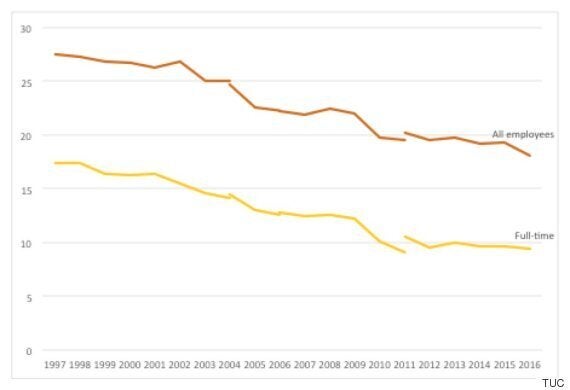The gender pay gap has barely budged. Since 2011 the full-time gender pay gap has fallen by just 0.2 percentage points a year. At this rate it will take over 40 years to achieve pay parity between men and women.
This means a young woman starting her career today will have to wait until her 60's before working full-time pays the same as it does for a man.
But that's just full-time workers. When you look at the whole female workforce, including both part- and full-time women, the picture is even bleaker. On this measure the gender pay gap almost doubles: in 2016, it hit 18.1%.
Gender pay gap (%), 1997-2016

Why is it taking so long to close?
There are lots of factors getting in the way of progress. Issues like occupational segregation (men and women doing 'traditional' jobs for their gender) and access to quality part-time work are huge factors. But the latest figures also point to a worrying trend in the public sector.
In the past, the public sector had a much smaller pay gap, and a better track record in reducing it. Part of that is because of skill level. Half of women working full-time in the public sector are in high-skilled jobs like teaching, nursing or midwifery. That's twice as many as the private sector, where less than a quarter do. The lower gender pay gap has also been linked to stronger unions in the public sector, and greater transparency on who gets paid what.
But today's figures show that after a couple of years of growth, the public sector the gender pay gap is almost 2 percentage points higher today than it was three years ago. The private sector gap has been closing much more quickly. This year that's likely to be because women (who do most of the low-paid work in the private sector, often part-time) will have felt the benefits of the National Living Wage. Why is this happening?
Gender pay gap, public and private sectors, 2005-2016

Job cuts and increasing work pressures
The early evidence suggests that public sector cuts impact negatively on women's pay and careers. Take the example of the civil service. Here, we know that the whole workforce gender pay gap widened from 12% in March 2015 to 13.6% in March 2016.
Why has this happened? Well, the size of the civil service workforce has fallen by a fifth since 2010. And most cuts have landed on administrative jobs, in roles largely done by women, but where the pay gap tends to be small.
While women are now better represented at the top (occupying 40% of senior civil service jobs now, compared to 34% in 2010), pay differences between men and women are much wider in more senior grades.
Then there is the issue of flexible working. Public sector unions are reporting that it is getting harder for members to access flexible work. The TUC recently surveyed union reps, and they agreed that things have got harder compared to two years ago. Another survey of local government workers found that the vast majority thought their workloads had increased in the past 12 months, and that many were working beyond their official hours.
These kinds of problems could force many women out of their jobs, because such demands can't always be juggled with caring responsibilities.
This trend is also evident in teaching. The biggest group of leavers from the teaching profession in recent times have been women in their 30s. It is no coincidence that this is when many will have young children.
The government must take responsibility for the impact of its policies. If Theresa May is serious about narrowing the gender pay gap, she must not turn a blind eye to the impact cuts are having.